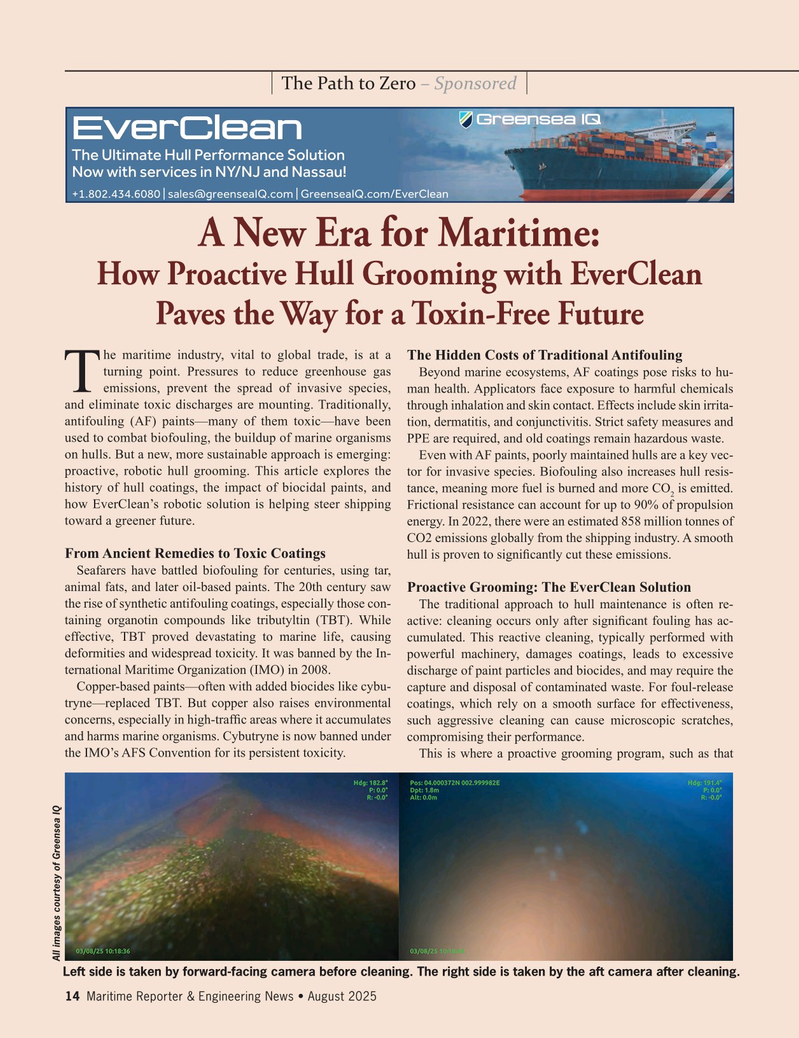
Page 14: of Maritime Reporter Magazine (August 2025)
Read this page in Pdf, Flash or Html5 edition of August 2025 Maritime Reporter Magazine
The Path to Zero – Sponsored
EverClean
The Ultimate Hull Performance Solution
Now with services in NY/NJ and Nassau!
+1.802.434.6080 | [email protected] | GreenseaIQ.com/EverClean
A New Era for Maritime:
How Proactive Hull Grooming with EverClean
Paves the Way for a Toxin-Free Future he maritime industry, vital to global trade, is at a
The Hidden Costs of Traditional Antifouling turning point. Pressures to reduce greenhouse gas Beyond marine ecosystems, AF coatings pose risks to hu-
T emissions, prevent the spread of invasive species, man health. Applicators face exposure to harmful chemicals and eliminate toxic discharges are mounting. Traditionally, through inhalation and skin contact. Effects include skin irrita- antifouling (AF) paints—many of them toxic—have been tion, dermatitis, and conjunctivitis. Strict safety measures and used to combat biofouling, the buildup of marine organisms PPE are required, and old coatings remain hazardous waste.
on hulls. But a new, more sustainable approach is emerging: Even with AF paints, poorly maintained hulls are a key vec- proactive, robotic hull grooming. This article explores the tor for invasive species. Biofouling also increases hull resis- history of hull coatings, the impact of biocidal paints, and tance, meaning more fuel is burned and more CO is emitted. 2 how EverClean’s robotic solution is helping steer shipping Frictional resistance can account for up to 90% of propulsion toward a greener future. energy. In 2022, there were an estimated 858 million tonnes of
CO2 emissions globally from the shipping industry. A smooth
From Ancient Remedies to Toxic Coatings hull is proven to signi? cantly cut these emissions.
Seafarers have battled biofouling for centuries, using tar, animal fats, and later oil-based paints. The 20th century saw
Proactive Grooming: The EverClean Solution the rise of synthetic antifouling coatings, especially those con- The traditional approach to hull maintenance is often re- taining organotin compounds like tributyltin (TBT). While active: cleaning occurs only after signi? cant fouling has ac- effective, TBT proved devastating to marine life, causing cumulated. This reactive cleaning, typically performed with deformities and widespread toxicity. It was banned by the In- powerful machinery, damages coatings, leads to excessive ternational Maritime Organization (IMO) in 2008. discharge of paint particles and biocides, and may require the
Copper-based paints—often with added biocides like cybu- capture and disposal of contaminated waste. For foul-release tryne—replaced TBT. But copper also raises environmental coatings, which rely on a smooth surface for effectiveness, concerns, especially in high-traf? c areas where it accumulates such aggressive cleaning can cause microscopic scratches, and harms marine organisms. Cybutryne is now banned under compromising their performance.
the IMO’s AFS Convention for its persistent toxicity. This is where a proactive grooming program, such as that
All images courtesy of Greensea IQ
Left side is taken by forward-facing camera before cleaning. The right side is taken by the aft camera after cleaning.
14 Maritime Reporter & Engineering News • August 2025 14 Maritime Reporter & Engineering News • August 2025
MR #8 (1-17).indd 14 MR #8 (1-17).indd 14 8/4/2025 8:32:51 AM8/4/2025 8:32:51 AM

 13
13

 15
15
